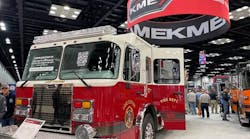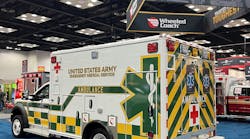The business end of the engine company is the rear hosebed area that carries the supply and attack lines on the rig. While normally not thought of as an important part of the apparatus, the hosebed and its design in the area that can make or break an evolution on the fireground.
With the advent of adjustable hosebed dividers several years ago, most departments simply load their hose on the new apparatus after making a few adjustments with the dividers so that the hose will fit completely flat in each tier and make sure that the amount of specified hose fits into the bed. This is not the time to decide that you want to acquire five-inch hose in place of the four-inch supply line that you have been using as well as trying to find a place to store your large-diameter hose (LDH) manifold. Proper planning in the design phase, together with the advice of an apparatus architect, will assist you in looking at all of these important areas before you specify the components on your new engine.
As you look at and evaluate some of current trends in fire apparatus design it is becoming clear that we are attempting to do more with less. This can be seen in the types of apparatus that are most commonly being purchased. Many fire departments have determined that instead of operating and staffing a separate engine and rescue unit that a combined rescue-engine is the way to go. Placing all of the normal engine company and some of the rescue equipment on a single piece of apparatus can be done, but something normally suffers. If you get all of the compartment space that you need it means that the ground ladders have to go somewhere else. No problem, you say, we'll put the ladders through the water tank and they will come right off the rear of the pumper. Well, what did we just do here?
The apparatus body must now be as long as the longest ground ladder, so if you are running with a 14-foot roof ladder and a 24-foot extension ladder, the body need to be at least 172 inches long to accommodate this equipment. When you run the ladders through or alongside the tank, this causes the height of the tank to increase, which in turn makes the hosebed higher at the rear as well.
Another factor which impacts the height of the hosebed is the size and configuration of the rear body compartments. Many engine companies are carrying hydraulic rescue tools of various sizes and these will be frequently be located in the rear compartment under the hosebed. A standard compartment at the rear of the body that is 30 to 35 inches high will generally not cause an adverse impact on the height of the hosebed as the top of the water tank will typically be higher than this point on the horizontal plane. Should you specify a full height compartment at the rear that is 55 to 65 inches high, now the entire back end of the engine got incrementally higher and the hosebed is now somewhere in the stratosphere.
The number and size of rear suction and discharge lines also have a large impact on the height of the hosebed from the ground. Booster tanks on pumper typically are a T-shape design with discharge piping run under the T area of the tank on each side. This will generally work for piping up to three inches in diameter. Larger plumbing will require a higher notch in the tank or may dictate that the piping be sleeved through the water tank in some cases. Both of these scenarios will require the overall height of the water tank to become greater and will increase the height of the hosebed floor. When the water tank is sleeved it costs more and could add maintenance concerns.
A cost-effective alternative is to plumb the rear pre-connects directly off the pump at the front of the hosebed. This provides for rear pre-connected hose loads, at a lower cost, with greater hydraulic efficiently, eliminating maintenance concerns and keeping the hosebed within reach of firefighters.
These factors, together with the size of the booster tank, all have a direct impact on the height of the hosebed at the rear of the pumper. The FDNY has used 500-gallon water tanks on its apparatus for a number of years, with several engines that are remote from water supplies on Staten Island being equipped with 750-gallon tanks. These units are equipped with L-shaped tanks that provide for a lower hosebed at the rear of the body. These hosebeds are approximately 56 inches from the ground, which makes stretching attack lines both safe and easy.
Consider a standard pumper equipped with a 750-gallon booster tank with a hosebed with four bays, including a bed of 1,500 feet of large-diameter hose. Using an L-shaped water tank with a standard rear compartment can provide for a hosebed that is 62 inches from the ground. A firefighter standing on the rear step can look down into the hosebed to grab the nozzle and hose folds prior to advancing the attack line. A pumper equipped with the same 750-gallon booster tank in a T-shape design with a large rescue-style rear compartment will have a hosebed that is 78 inches from the ground. While standing on the rear step of this apparatus, you will probably have to ascend another fold-down or fixed-style step to reach the hosebed to stretch the attack line.
Now imagine a pumper equipped with a 1,000-gallon T-shape water tank with a large rear compartment and a five-inch rear suction. The hosebed on this apparatus is somewhere around 90 inches in the air and once you get onto the rear step, you have to climb two or more smaller steps to even reach the hosebed. Is it any wonder that a high number of firefighters sustain injuries while climbing on or about apparatus during the year? Who is to blame for this situation?
If you attempt to combine a lot of features into one apparatus, you will generally improve in some areas while adversely impacting others. Looking at the current trends in engine company apparatus design would lead you to believe that present-day firefighters are as tall and agile as basketball players on the fireground. Unfortunately, one of the basic missions of the engine company is compromised because we cannot safely and effectively lay a supply line and stretch attack lines without getting some of our personnel injured.
Properly designed engines should be capable of deploying their rated pump capacity through pre-connected attack lines and master stream appliances. If your department determines that a combination of crosslay and rear hosebed attack lines is beneficial, then consider locating the shorter lines, such as 150-foot or 200-foot-long lines, in the crosslays with the longer lines coming off the rear. Whenever possible, the lines should be loaded to enable one firefighter to stretch the line without having to climb all over the rig searching for the nozzle.
Attack lines that are loaded in a shoulder load or minuteman configuration allow personnel to advance the line without having to climb on the apparatus and makes it easier to deploy the line. Longer attack lines or leader lines coming off the rear are much easier to advance, particularly when the engine has pulled past the building to leave the front open for the truck or special service apparatus.
If high-capacity handlines capable of flowing 500 gpm or greater are required, then consideration should be given to using a minimum of three-inch piping and valves for these discharges. Special appliances such as hydrant valve, manifold or portable guns which are mounted at the rear should be located so that personnel can deploy them without having to climb on the apparatus. Also, they should be positioned so that these devices do not inhibit standing on the rear step when required during handline stretches or packing hosebeds.
In the next installment of "The Apparatus Architect" we will wrap up our discussions on the engine company with some examples of well-designed apparatus and how they improved department operations.
Tom Shand is a firefighter with the Newton-Abbott Volunteer Fire Department in the Town of Hamburg, NY, and a senior instructor at the Onondaga County Community College Public Safety Training Center. He is employed by American LaFrance and is assigned to the Hamburg Facility in the apparatus sales department. Michael Wilbur, a Firehouse® contributing editor, is a lieutenant in the New York City Fire Department, assigned to Ladder Company 27 in the Bronx, and has served for the past five years on the FDNY Apparatus Purchasing Committee. He has consulted on a variety of apparatus related issues throughout the country. Previous installments were in August, October and November 2000; February, May, June and July 2001; and January, May, July and October 2002 issues.







